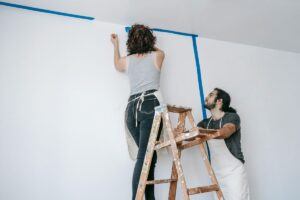You probably have seen DIY chalkboards on Pinterest. Everyone loves to draw on chalkboards, especially kids. When you have kids, you want them to have a blast without spending a lot of money, which is why you need to try this DIY outdoor chalkboard with your kids. Making your own outdoor chalkboard for your kids is rewarding because it is a fun project that you and your kids can do together.
After a long weekend, it is time to start this Pinterest project needed to start. A project won’t be done until you start!
If you like to make an outdoor chalkboard, follow these directions and use the products that are suggested.
Materials Used:
- (1) 3X5 foot Cement Board (typically used behind shower tiles, waterproof/weatherproof)
- 1 quart of exterior latex paint, black
- 1 package of un-sanded tile grout
- (3) 8-foot pieces of trim (optional) and screws to attach to cement board
- 1 quart of exterior high gloss latex paint for trim, bright color! (optional)
- 3-4 disposable mini paint rollers
- 1 mini paint tray
- 2 large paint rolls and 1 large roller
- 1 large paint tray
- tin foil (optional)
- 6 deck screws
- plastic spoons
- a plastic disposable container
Optional Materials
- 1 measuring cup
- 1 tablespoon
Step 1:
First, you want to lay the cement board on a flat raised surface where it will stay clean; Dust off any debris and wipe it with a damp cloth but do not soak it with water.
Put black (base) paint in a disposable container. Add un-sanded tile grout a little bit at a time and stir with a paint stick or any disposable item (make sure you read everything on the package and be careful since there warning signs of corrosive )
IMPORTANT!!: DO NOT MIX TOO MUCH PAINT/GROUT AT A TIME BECAUSE IT GETS VERY THICK AND STICKY VERY QUICKLY. MIX ENOUGH FOR A COAT (ONE CUP) AND MIX AGAIN FOR ADDITIONAL COATS OF PAINT.
Step 2:
With your disposable foam roller and aluminum foil-lined tray, you want to put 3-4 coats of paint on the cement board give the cement board. You want to let it dry thoroughly between coats.
Step 3: (OPTIONAL FRAMING)
Even though the paint dries pretty fast, you can let the board sit overnight if you want to make sure it dries completely before moving on with framing and prepping the new chalkboard surface.
With a handheld saw, you want to measure and cut the trim pieces to fit around the frame. If you want to be extra fancy, you can cut it at a 45-degree angle or a square to fit them nicely.
Next, you can screw the frames on the chalkboard. If there are rough edges, you can sand them down and wipe them with a damp cloth. Once everything is done, you can move on to painting.
Step 4: (OPTIONAL FRAMING)
You want to mask the edges against the black chalkboard and scrape the edge to make sure the trim color doesn’t bleed onto the board.
You can then start painting 2 to 3 coats of trim paint. Depending on the color of the trim, you may need only 2 instead of 3.
Step 5: “PRIME” the surface
You don’t need expensive material to “prime” the surface. You can use the cheap chalk (not the Crayola fancy bright colors)
This part is messy, but it makes a huge difference. Basically, you use several pieces and cover the entire surface with a thick layer of chalk, rubbing them in every direction.
It is said that if you don’t “prime” the surface, the first few drawings may stay visible in a hazy outline for a while no matter how many times you wipe and wet it down. If you don’t want that to happen, you want to do a fabulous job of priming the surface.
If you want to cut down on some of the chalk dust, you can use a Shop-Vac to clean up it and brush it with a soft hand brush.
Step 6: (Mounting the Chalkboard)
Most people mount their chalkboard on their fence, but you can put it wherever you please. Depending on where you live, you might want to consider the season for your kids. If you have no winter throughout the year, mounting on a fence sounds reasonable. If you do have winter, mounting it in a garage sounds like the best option.
Using “Liquid Nails,” you can attach a small board on the back of the chalkboard and let it dry overnight.
After that, you can screw the sides of the chalkboard (on the trim) and the TOP of the anchoring board glued to the back to a horizontal board on the fence, which worked out to be the right height for a toddler to have full access to the entire chalkboard.
Depending on the construction of your fence or wall, you may choose a different way to “mount” the chalkboard to your surface. Make sure the chalkboard is attached safely and securely so that there won’t be any injuries to your kids. You don’t want a cement board comes crashing down on your kid now, do you?
Step 7:
You can now ENJOY your new outdoor activity! Your neighbors will be in awe of your creativity! They might be even jealous of the amazing project that you just finished.
This chalkboard can last for a long time, and your kids can enjoy drawing for years to come! It is a great outdoor activity for your kids when they are bored.
Featured image credit: Shutterstock
Tim Thomas is a renowned writer and entrepreneur specializing in finance, investing, and money matters. With his extensive knowledge and experience in the financial sector, Tim offers valuable insights into the world of personal finance, stock market trends, and investment strategies.





